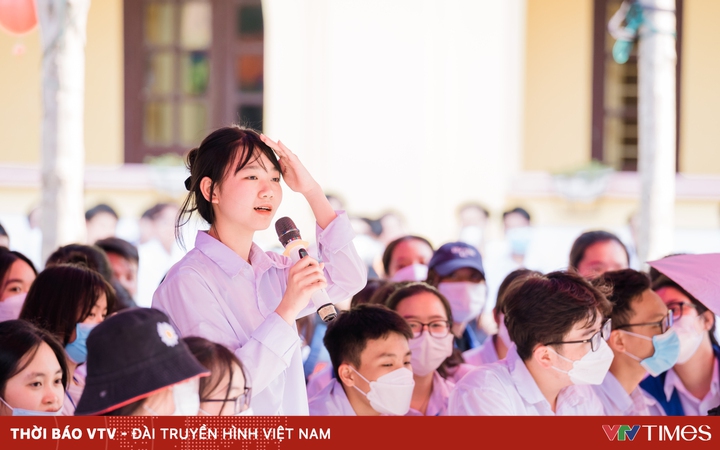Textbooks are reference materials in the US, are freely distributed in Japan and Russia, and do not exist in Australia.
Mr. Huynh Thai Binh – currently a Vietnamese teacher at Bonnyrigg High School, Sydney city, New South Wales state – has been teaching at Bonnyrigg for more than 30 years. Australia.
Mr. Binh said that schools in Australia no textbooks which teaches according to the syllabus (outline, curriculum) given by the examination office of the state education agency. Teachers actively choose materials and books to teach students, as long as they meet the knowledge and content of the program.

Mr. Binh and Nguyen Ly Tam Nhu, a female student who won the New South Wales Outstanding International Student Award from Bonnyrigg High School where Mr. Binh works, on graduation day last year. Image: Tam Nhu
At the beginning of each semester, teachers inform students about topics for them to understand and prepare for. There are no textbooks, so teachers face certain difficulties in finding materials. But according to Mr. Binh, in order to bring knowledge and interesting lectures, teachers must explore, study documents and innovate teaching methods. The level of students is different each year, so teachers must be flexible in the way they teach and communicate so that the students can absorb the best knowledge.
According to Dr. To Thi Vinh, senior lecturer at the School of Education, University of Tasmania, Tasmania, Australia has a national standard curriculum for each class. Each state has autonomy, so the curriculum in the states may be similar or more or less different from the national curriculum; may even change to suit the situation and policy of each state.
Australian teachers have the ability to create their own lesson plans and find teaching materials for students, based on common standards. They are free to be creative as long as it is suitable for the proposed program. Australia also has a system of supplementary books for each class and teachers can refer to.
“The advantage of this is to promote the autonomy and creativity of teachers,” commented Dr. Vinh.
The female lecturer added that education in Australia is free, parents only have to pay a small amount for notebooks and school supplies (pencils, pens, erasers) at the beginning of the year.
Unlike Australia, schools in America there are textbooks. However, teachers mainly rely on the curriculum framework (curriculum map, pacing guide), rarely using textbooks.
According to Master Dinh Thu Hong, primary school teacher of Gwinnett School District (Georgia), in the past two years, due to the Covid-19 situation, online teaching is the main thing (besides the hybrid-mixed model), her school and many schools otherwise do not use textbooks at all; if any, is on the online platform.
The framework will be developed by the district and followed by schools. The program is divided into two semesters, two quarters each, nine weeks each quarter, covering certain standards. For example, in Math last quarter, Ms. Hong’s 3rd graders learned about standards for rounding numbers, adding and subtracting to within 1,000 and multiplying and dividing within 100.

Hong’s September 2020 lecture on how to find the result of multiplication using the equal groups strategy. Image: Characters provided
Each school, school district, or school district uses different sets of textbooks. Master Hong added that the selection of which books and which company’s curriculum is the result of working between each school or school district and the publishing company. Textbook costs are covered by the school.
“The children use books at school, not bring them home,” said Ms. Hong.
In addition to textbooks for students, the US also has a series of accompanying products such as teacher’s edition or TE books, materials for each group of good and bad students, CD or DVD sets…
However, all of them are only considered as reference materials for teachers to rely on to have an overall and detailed view when preparing lessons. “Teaching is teaching concepts (concepts) and skills (skills), teachers don’t teach exactly like textbooks. Textbooks only account for 15-20% of the material,” Ms. Hong said.

A set of 1st grade textbooks in Japan. Image: Shinko-keirin
LIVE RussiaStudents do not lose money to buy textbooks. Ms. Nguyen Thi Hoai Phuong, from Ufa city, said that education here is free and parents only have to pay a small amount at the beginning of the year to the parent association to buy school supplies.
Ms. Phuong has two children attending primary and secondary school at school number 94. The school distributes books at the beginning of the year and collects them at the end of the year. Children can bring books home to study.
Similarly, in Japan, textbooks also have many sets and students do not need to buy. According to Mr. Nguyen Duy Anh, Rector of GAG Japanese Language Institute in Fukuoka city, public schools can choose their own set of appropriate textbooks. Private schools have more autonomy, so they will choose to study according to books or compose their own content according to the prescribed curriculum framework.
Textbooks will be distributed free of charge to students in public schools. Private or charter schools often include the purchase of books in their tuition.
The back of each book is printed with the message: “This textbook is sent to you as the future owners of Japan. The book is distributed free of tax money from the people. Please use it wisely. careful”.
Dawn
at Blogtuan.info – Source: vnexpress.net – Read the original article here



